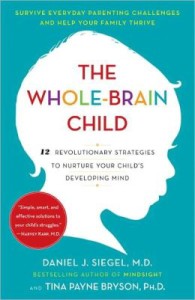Getting to know more about the human brain can strengthen your parenting skills, especially when it comes to tantrums, fears, and coping with scary experiences. “The Whole-Brain Child,” by Daniel J. Siegel, M.D. and Tina Payne Bryson, PhD, is an excellent, readable book that provides tools and understanding about what’s going on in your child’s brain when they get “out of control,” and how you can use this understanding to soothe and get through to them quickly.
The brain develops throughout childhood and consists of different parts with highly specialized functions. For example, the “downstairs brain” (brain stem and limbic system), as authors Siegel and Bryson describe it, is responsible for involuntary survival functions, like breathing and the “fight or flight” reaction to danger. It’s also home to the emotions we feel when threatened: anger and fear. This part of the brain is well-developed from birth.
In contrast, the “upstairs brain” (cerebral cortex), home of sophisticated functions like self-control, empathy, decision-making, and morality, is not fully developed until early adulthood! Toddlers, therefore, simply do not have the brain capacity to be upstanding citizens all the time.
Siegel and Bryson assert that brain integration (coordination and communication across different regions of the brain) leads to mental well-being in children and adults. As parents, we can help our children thrive by fostering brain integration. For example, here is a look at how brain science can help us understand tantrums and how to handle them.
TAMING A TANTRUM
Pre-schoolers are infamous for their tantrums. Individual temperament varies, but most parents know what it’s like to be with a toddler, who is red in the face, flailing about, and screaming about something they really want (more cake, a longer playdate, another child’s trike) but just can’t have. If you have ever tried to appeal to a raging toddler with reason and logic, you know… it just doesn’t work! Brain science tells us why.
Tantrums are a form of fight or flight response driven by the lower brain emotions of anger and/or fear. Once a toddler’s “downstairs brain” is simmering in stress hormones, they can’t access their upper brain to gain self-control. So, next time you are exasperated with a raging toddler. Remember, they are not being manipulative. They are literally stuck in the dungeon of their downstairs brain. Punitive statements, like“No more play dates for you,” will only send them deeper into the dungeon.
To connect with your tantruming toddler, start by soothing their “downstairs brain.” Reflect their feelings: “That makes you really mad!” Comforting them with, perhaps, a hug or a glass of milk and a reminder, “I love you even when you are mad at me.” Once the stress hormones have subsided and they calm down, you can engage with their “upstairs brain,” particularly with children ages 4 and up. “Why do you think you got so mad?
By soothing first, and discussing later, you are engaging with both the “downstairs” and the “upstairs” brain. Once you start asking them to use their upper brain to think about this lower brain “Would it help you to have more warning time before the end of your next play date?” you are helping them to integrate their brain. They may then be able to cope with the next frustration better.
RECOGNIZING HOW MUCH YOU ARE DOING ALREADY
Siegel and Bryson’s book is filled with simple parenting strategies based on brain research. In reading it, you may find that you are already implementing some of them. One of the exciting things about the latest brain research is that it explains and validates our natural parenting instincts, as well as the parenting tools laid out in other popular parenting books, such as “The Happiest Toddler on the Block” by Harvey Karp, M.D.
Written by Laelia Gilborn, M.S.W.,M.P.H., Ms. Gilborn holds two Masters Degrees in both Social Work and Public Health. She has additional training in child-centered play therapy and other therapeutic approaches to working with children. She has a special interest and experience with supporting families who are coping with health-related challenges and grief and loss issues.
